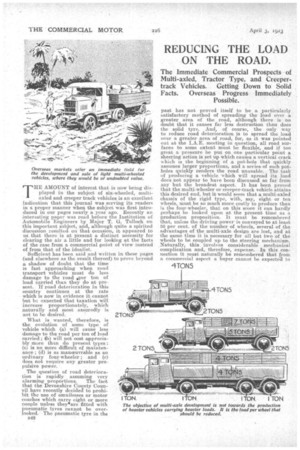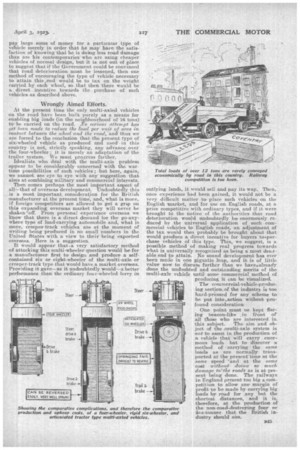REDUCING THE LOAD ON THE ROAD.
Page 26

Page 27

If you've noticed an error in this article please click here to report it so we can fix it.
The Immediate Commercial Prospects of Multi-axled, Tractor Type, and Creeper-. track Vehicles, Getting Down to Solid Facts.. Overseas Progress Immediately Possible.
THE AMOUNT of interest that is now being displayed in the subject of six-wheeled, multiaxkd and creeper track vehicles is an excellent indication that this journal was serving its readers in a proper manner when the subject was first introduced in our pages nearly a year ago. Recently an interesting paper was read before the Institution of Automobile Engineers by Major T. G. TuHoch on this important subject, and, although quite a spirited discussion resulted on that occasion, it appeared to us that there is at present a distinct necessity for clearing the air a little and for looking at the facts of the ease from a commercial point of view instead of from that of the idealist.
Sufficient has been said and written in these pages (and elsewhere as the result thereof) to prove beyond a shadow of doubt that the time is fast approaching when road transport vehicles must do less
damage to the road oper ton of load carried than they do at pre
sent. If road deterioration in this country continues at the rate which is now in evidence it cannot but be expected that taxation will increase proportionately, which L naturally and most assuredly is S
not to be desired. 2 TONS What is wanted, therefore, is the evolution of some type of vehicle which (a-) will cause less
• damage to the road per ton of load carried.; (b) will not cost appreciably more than do present types; (c) is no more difficult of maintenance ; (d) is as naanceuvrable as an ordinary four-wheeler ; and (e) does not require any greater propulsive power.
The question of road deterioration is rapidly assuming very alarming propertions. The fact that the Devonshire County Council have recently decided to prohibit the use of omnibuses or motor coaches which carry eight or more people unless they*are fitted with pneumatic tyres cannot be overlooked. The pneumatic tyre in the B42
past has not proved itself to be a particularly satisfactory method of spreading the load over a greater area of the road, although there is no doubt that it causes far less destruction than does the solid tyre. And, of course, the only way to reduce road deterioration is to spread the load over a. greater area of road, for, as it was pointed out at the I.A.E. meeting in question, all road surfaces to some extent must be flexible, and if too great a pressure be put on one particular point a sheering action iS set up which causes a vertical crack which is the beginning of •a pot-hole that quickly assumes larger proportions, and a series of such potholes quickly renders the road unusable. The task of producing o, vehicle which will spread its load does not appear to have been discussed so far from any but the broadest aspect. It has been proved that the multi-wheeler or creeper-track vehicle attains this desired end, but it would seem that a multi-axled chassis of the rigid type, with, say, eight or ten wheels, must be so much more costly to produce than is the four-wheeler, that on this score it can hardly perhaps be looked upon at the present time as a production proposition. It must be remembered that, unless the driving power is conveyed to at lea,st 60 per cent, of the number of wheels, several of the advantages of the multi-axle design are lost, and at the same time it, is necessary for all but two of the wheels to be coupled up to the steering mechanism. Naturally, this. involves considerable mechanical complication and, therefore, expellee. In this connection it must naturally be remembered that from a commercial aspect a buyer cannot be expected to
pay large sums of money for a particular type of vehicle merely in order that he may have the satisfaction of knowing that lie is doing less road damage than are his contemporaries who are using cheaper vehicles of normal design, but it is not out of place to suggest that if the Government could be convinced that road deterioration must be lessened, then one method of encouraging the type of vehicle necessary to attain this _end would be to tax on the weight carried by each wheel, so that then there would be tt. direct incentive towards the purchase of such vehicles as described above.
Wrongly Aimed Efforts.
At the present time the only multi-axled vehicles On the road have been built purely as a Means for enabling big loads (in the neighbourhood of 1.& tons) to be carried on the road. _No serious attempt has yet been made to reduce the load per unit of circa in contact between the wheel and he road, -and thus we are forced to the conclusion that the present type of six-wheeled vehicle as. produced and used in this country is not, strictly speaking, any advance over the four-wheeler.; it is merely an adaptation of the trailer system. We must progress farther.
Idealists who deal with the mufti-axle problem appear to be considerably concerned with the wartime possibilities of such vehicles ; but here, again, we cannot see eye to eye with any suggestion that aims at combining military and commercial interests.
Then comes perhaps the most important aspect of all—that of overseas development. Undoubtedly this is a most important consideration for the British manufacturer at the present time', •and, what is more, if foreign competitors are allowed to get a grip on this expanding overseas market they will never be shaken'aff. From personal experience overseas we know that there is a direct demand for the go-anywhere typo of load-carrying automobile and, what i more, creeper-track vehicles are at the moment of writing being produced in no small numbers in the United States with a view to their being exported overseas. Here is a suggestion.
It would appear that ,a very satisfactory method of attacking this multi-wheeler question would be for a manufacturer first to desigii andproduce a selfcontained six or eight-wheeler of the multi-axle or creeper-track type that would have a market overseas. Providing it gave—as it undoubtedly would----a better performance than the ordinary four-wheeled lorry in outlying lands, it would sell and pay its way. Then, once experience had been gained, it would not be a very difficult matter to place such vehicles on the English market, and for use on English roads, at a price competitive with ordinary types and if it were brought to the notice of thg authorities that road deterioration would undoubtedly be enormously redneed. by the universal application of such corninercial vehicles to English roads, an adjustment of the tax would then probably be brought about that would produce a direct incentive for buyers to,purchase vehicles of this type. This we suggest, is a possible method of making • real progress towards what is universally recognized as being a most desirable end to attain. No sound development -has ever been made in one gigantic leap, and it is of. little value now to discuss further than we have.Talready done the undoubted and outstanding merits, of the multi-axle vehicle until some commercial method of producing it can be visualized.
Thp commercial-vehicle-producing section:of the industry is too hard-pressed for any scheme to be put into,actiou without profound consideration "One . point must ne kept flaring beacon-like in front of all those who are interested in
this subject. The . aim and object of the Imulti-axle system is not to assist in. the production• of a vehicle .that will carry enormous loads but to discover a method of -carrying the seine loads as are normally transported at the present-time at the same speed and at the same cost withoutrioina so much damage to' the roads as is at present being done. The railways. in England present too big acornpetition to allow any. margin of profit to be made by carrying big loads by road for any but the shortest, distances, and it is, therefore, at the production of. the non-road-destroying four or five-foriner that the British industry should aim.
































